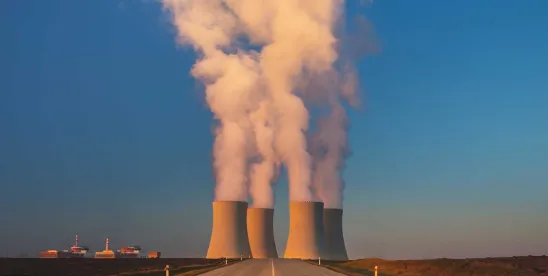On May 23, 2025, President Donald Trump signed four executive orders aimed at launching a “renaissance” for the U.S. nuclear energy sector. The orders announce objectives of deploying 300 GW of new nuclear energy capacity by 2050 (a fourfold increase over current levels) and having 10 large reactors under construction in the United States by 2030. To achieve these objectives, the White House is calling for reforms to the Nuclear Regulatory Commission (“NRC”), the build-out of a domestic nuclear fuel supply chain, construction of reactors on military installations, and export promotion for U.S. nuclear technologies.
Reforming the NRC
The Ordering the Reform of the Nuclear Regulatory Commission executive order criticizes the NRC for “throttling nuclear power development” by implementing multi-year licensing processes characterized by excessive risk aversion. The order and an accompanying fact sheet build on recently-enacted legislation—the Accelerating Deployment of Versatile Advanced Nuclear Energy Act of 2024, P.L. L. 118-67 (the “ADVANCE Act”)—which directed the NRC to revise its mission statement to ensure that its regulations not only ensure safety but also account for the societal benefits of nuclear energy.
The White House directive calls for a reorganization of the NRC, including reductions in force; however, the order recognizes that certain functions, such as new reactor licensing, may increase in size. The White House also directs the NRC to streamline and expedite its licensing processes in various ways, including by adopting an 18-month deadline for a final agency decision on applications to construct and operate any type of new reactor, establishing a process for high-volume licensing of microreactors and modular reactors, and eliminating "non-essential or obsolete" rules.
Additionally, the order directs the NRC to reconsider its reliance on the linear no-threshold (“LNT”) model for radiation exposure, and the “as low as reasonably achievable” (“ALARA”) standard, which is predicated on the LNT model. According to the order, the LNT and ALARA policies exemplify the NRC’s extreme risk aversion and represent a major obstacle to licensing new reactors. As part of its reconsideration, the NRC must consider adopting “determinate radiation limits,” in consultation with the Environmental Protection Agency and other agencies. Such reconsideration might lead the NRC to align its standards with the quantified “ample margin of safety” hazardous air pollution standard codified by Congress in the 1990 Clean Air Act amendments, which applies to radiation exposure from reactors.
The NRC may face pressure to address these new directives in its ongoing rulemaking to establish a risk-informed, technology-inclusive regulatory framework for advanced reactors (the so-called “Part 53” rulemaking).
Building a Domestic Fuel Supply Chain
The Reinvigorating the Nuclear Industrial Base executive order addresses a vulnerability in the U.S. nuclear sector: its dependence on imports of foreign sources of enriched uranium, particularly from Russia.
To address this import dependence, the order directs the Department of Energy (“DOE”) and the Department of Defense to make excess uranium from federal stockpiles available for commercial use where feasible. It also calls for the immediate development of domestic capabilities for uranium conversion, enrichment, and fuel fabrication—including for advanced reactor fuels such as high-assay low-enriched uranium (“HALEU”). HALEU is essential for several next-generation types of reactors.
The order also directs the DOE to prioritize the facilitation of 5 GW of power uprates to existing reactors, have construction underway on 10 new large reactors by 2030, and make resources available for restarting closed nuclear power plants.
Additionally, the White House seeks to expand the industry workforce by instructing the Secretaries of Labor and Education to establish ways of increasing participation in nuclear energy-related education and career pathways.
Deploying Reactors for (and by) the National Security Apparatus
The Deploying Advanced Nuclear Reactor Technologies for National Security order focuses on utilizing nuclear energy for national security purposes. The order calls on the Departments of Defense and Energy to utilize government sites for the development of advanced reactors.
Under the order, the Secretary of the Army is tasked with commencing operation of a reactor on a domestic military base or installation no later than September 30, 2028.
The order also establishes a 90-day deadline for the Secretary of Energy to designate DOE sites for the use and deployment of advanced reactors—with a special emphasis on powering AI infrastructure.
Finally, the order instructs the Secretary of State to implement several policies to promote exports of U.S. nuclear technologies, including “aggressively” pursuing at least 20 new agreements with other countries by January 3, 2029.
Leveraging DOE Authorities to Build “Test Reactors”
The order titled Reforming Nuclear Reactor Testing at the Department of Energy instructs the DOE to accelerate development of new reactors through pilot programs and streamlining environmental reviews. The order specifically asserts that advanced reactors that are not used for commercial electricity generation are collectively for “research purposes” and can be licensed by DOE rather than the NRC. The DOE is required to set up an expedited licensing and permitting process that will enable these “qualified test reactors” to be safely operational within 2 years of application submission and is charged with approving at least three reactors with the goal of achieving criticality in each by mid-2026.
Conclusions
The executive orders come at a time when the United States is grappling with increasing electricity demand driven by electrification, AI workloads, and the growing need for reliable, clean baseload energy. Nuclear reactors offer reliability and density, capable of supporting 24/7 operations with carbon-free power. Advanced reactors hold the promise of safer and more modular designs.
To achieve the ambitious capacity growth objectives, the executive orders seek to cut regulatory red tape and leverage various federal streamlining authorities. It remains to be seen whether simultaneous, mandatory cuts of experienced staff at the regulatory agencies will impede these goals. Furthermore, funding is a key part of the puzzle for the nuclear sector, particularly for advanced reactors. In this area, developers may have concerns about recent developments in Congress. The recently passed House budget reconciliation bill significantly diminishes the DOE Loan Programs Office, which has been a key source of financing. The House bill also limits the availability of clean electricity tax credits for advanced reactors. The bill would confine tax credit eligibility to reactors for which construction commences no later the end of 2028. This is a modest reprieve from earlier, far more restrictive versions of the bill. However, developers of advanced reactors may struggle to assemble the workforce, components, and financing to break ground by that date. In addition, the House bill does not spare owners of existing reactors; it would phase out the 45U tax credit at the end of 2031.






 />i
/>i

